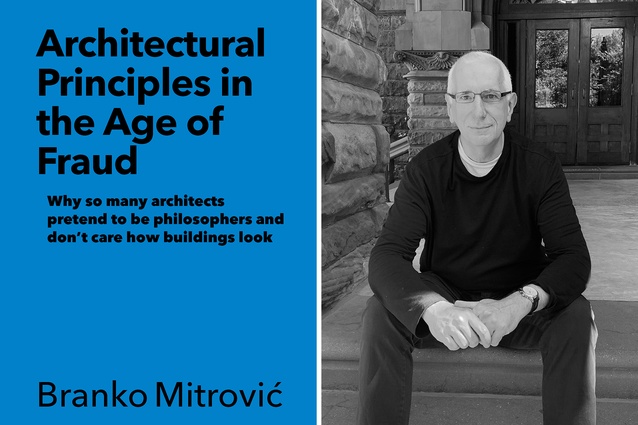Review: Architectural Principles in the Age of Fraud
Professor of Architecture and Planning at the University of Auckland, Mike Austin, reviews Architectural Principles in the Age of Fraud: Why so many architects pretend to be philosophers and don’t care how buildings look, and finds it to be a scathing criticism of later manifestations of early modernism.
Branko Mitrović was a valued member of staff at Unitec in Auckland where he taught classical architecture, a subject that tended to be dismissed by colleagues because of its association with other places and times. Mitrović had long criticised the notion of the zeitgeist and, as Alan Colquhoun has pointed out in Modernity and the Classical Tradition, “The facts suggest that classicism cannot be identified objectively with any particular content or ideology”.1 Mitrović has also written Learning from Palladio, where he says: “Palladio has much to teach us and it is appropriate to look at his works not only to learn about his times, but also to learn how to apply his design principles to the architecture2 of the present”. Mitrović has doctorates in philosophy and architecture and is the author of Philosophy for Architects.3
In his latest book, after an interesting analysis of early modernism (pointing out the lack of architectural education of its heroes, Le Corb, Mies and FLW), he conducts a scathing criticism of its later manifestations in the ‘misemployed’ philosophies of phenomenology and deconstruction.
Mitrović says: “The core of the modernist agenda in architectural design were thus two major negative (original emphasis) principles: the rejection of traditional methods of façade ornamentation and the rejection of spatial composition.”4 It could be argued that façades are still ornamented (perhaps guiltily) but spatial composition is no longer taught in most architectural schools. At Auckland, where the teaching of architectural history was suspended at one stage, the textbook was The Principles of Architectural Composition by Howard Robertson.5 Composition has become the elephant in the studio, where Mitrović claims: “The most elementary observation is the problematic status of the visual and formal that stands at the core of the debate”.6
The bulk of this latest book is given over to what he calls the ‘Obfuscatory Turn’. He says: “It is a strategy of vehement, emotional denial that modernist architecture – the only kind of architecture that by the 1970s architects knew how to design and academics could teach – is visually, formally and aesthetically inferior to pre-modernist approaches to design.”7 Mitrović proposes a general theory and typology of obfuscation, and a detailed criticism of its practice.8 He starts with a critique of Norberg-Schulz’s use of Heidegger, both of whom many students will have spent much time trying to understand; Mitrović labels Norberg-Schulz as the founding father of the ‘Obfuscatory Turn’.9 The phenomenologists are Pallasmaa and Frampton, who seem, still, to be popular with students.
Deconstruction takes a whole chapter with Eisenman, Wigley and Tschumi but Mitrović suggests that deconstructionists and phenomenologists differ in their use of obfuscation: the former wanting to be seen as talking the language of the avant-garde10. The chapter discusses the collaboration of Derrida (the philosopher of deconstruction) and Eisenman. Mitrović claims that “It is, however, undeniable that Derrida rejected Eisenman’s endorsement of ‘absence,’ whatever this latter term, crucial in the writings of both Derrida and Eisenman, might mean.”11 This takes us forward to the ’90s, when we come to a chapter entitled ‘The Abyss,’ where Mitrović proposes: “The demise of continental philosophy has left architects and architectural theorists who want to call themselves ‘the avant-garde’ without a source of new phrases that would qualify themselves as the avant-garde”.12
The final chapter is titled ‘Beyond Salvage?’, where earlier Mitrović has concluded that “it is not clear that there is something that architects can do that other professions cannot do better”.13 It ends with an ‘Obituary to a Profession’, where he says “architecture (though not necessarily by people who call themselves ‘architects’) will necessarily play an important role in human society, since the need for beauty and repulsion for ugliness cannot die”.14
Read a response to this review from Peter Parkes here.
References
1 Alan Colquhoun, Modernity and the Classical Tradition, Cambridge, Mass., The MIT Press, 1989. p. 205.
2 Branko Mitrović, Learning from Palladio, New York, W. W. Norton & Company, 2004, p. 36. (Is this title 8 possibly provoked by Robert Venturi, Steven Izenour and Denise Scott Brown’s Learning from Las Vegas?).
3 Branko Mitrović, Philosophy for Architects, New York, Princeton Architectural Press, 2011.
4 Mitrović, 2022, p. 22.
5 Howard Robertson, The Principles of Architectural Composition, London, The Architectural Press, 1924.
6 Mitrović, 2022, p. 171.
7 Mitrović, 2022, pp. 134–135.
8 Mitrović, 2022, p. 55.
9 Mitrović, 2022, p. 46.
10 Mitrović, 2022, p. 87.
11 Mitrović, 2022, p. 73.
12 Mitrović, 2022, p. 115.
13 Mitrović, 2022, p.115.
14 Mitrović, 2022, p. 137.










